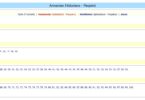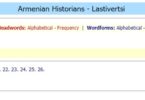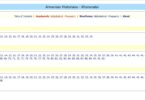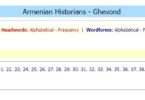The Narek Millennium: Lent and Renaissance
May this book be recited to the ears of generations,
and may it be preached to all peoples – The Narek, Prayer 88b
Lent is a fitting time to take stock of ourselves and our nation with Narek as our inspirational guide. In 2003 the Narek Millennium came and passed. How are we different from a year ago? From 1000 years ago?
A thousand years ago, on the south-east shore of Lake Van, within eyeshot of the newly built Cathedral of Aghtamar, a monk named Gregory wrote an inspirational book addressed to all nations for all generations. In 1003 this was an acceptable aspiration for an Armenian saint, an indication of the place and role of the Armenian nation and church in the world of those times. Reflecting on the Narek Millennium should remind us of that role, how and why it was achieved, and how and why it evolved into our current national mentality and trajectory.
For St. Gregory of Narek, the Armenian Church and nation are the keepers of a precious tradition. He understood himself as steward of the faith brought to Armenia directly by two of Jesus’ apostles, Sts. Thaddeus and Bartholomew, and firmly rooted in our national character by St. Gregory the Illuminator. It is a special mission to be the people of the land of Ararat and Etchmiadzin, “the Bethlehem of the Armenian soul,” as His Holiness Karekin II called it in his 2003 Christmas message.
Gregory means “awake, vigilant,” the state of all people of faith and hope, who await a better future. Like our patron saint, we are an expectant people. And that expectation reaches its height in times of rebirth and regeneration, like those we are privileged to be living today.
St. Gregory of Narek, lived in one of those rare times, the lull after the storm of Byzantine and Arab conquests, “a tranquil interlude,” like today. He seems to have understood that peaceful times are but a short respite in the turmoil and tumult of history. They are times for innovation, and the creative should seize the day. So with saintly prescience in the spirit of the Armenian Renaissance, he set out to build an “edifice of faith” that cannot be destroyed. Recall that St. Gregory of Narek’s Armenia was the land of Ani, the city of a thousand and one churches; of Aghtamar, the magnificent carved island monastery; of our triumphant, national epic, David of Sassoon; and of the great centers of learning at Haghbat, Sanahin and Kecharis.
Narek’s edifice of faith outlasted most of the thousand and one churches of Ani and sustained our people through a thousand and one years of hardship. It was almost as if our saint saw what was coming and provided a salve for our wounds. And a potent salve it was, for body and soul. Our people took it to heart. After the Bible, the Narek was among the earliest and most often printed and read books of the Armenian people: more than 50 printings from 1673 to 1875, an indicator of the level of literacy and culture awareness of our people even in dark times.
Our times today are in many ways like his times a thousand years ago: amidst the clash of empires, a tranquil interlude brimming with resources to rebuild our country. Perhaps for the first time in a thousand years we are again poised to re-“cognize” our place in the family of nations and in Christendom. Perhaps 2004 will be the year that we endow our national existence with new meaning and espouse a potent message of renewal for ourselves and all peoples, near and far, large and small, strong and weak.
St. Gregory of Narek is the Armenian guidebook to restoration and reinvention. While the Narek has numerous mystical moments, St. Gregory’s goal, in his own words, was to provide “practical advice.” He likens his book to an encyclopedia of the human condition. The Narek is designed to bring our spirit back into balance by recalibrating our moral compass. It is a course of spiritual exercises and spiritual formation.
We exercise every day – physically and intellectually. Why exercise the spirit? So we are ready to do life’s real heavy lifting, for it rains on the just and the unjust, and no mortal soul escapes trying times of moral choice, injustice, and disappointment. This well-developed Armenian spirit, trained and nurtured by the Narek, had the resilience to endure through the centuries, to continue to expect good despite harrowing evil, to strive
— in Saroyan’s words — to “bring goodness out of its hiding place and set it free and unafraid.”
Lent is often thought of as a time of giving up the things we like. It is in reality a time of shedding things we don’t need, clearing the clutter in order to make the most of the good things we have been blessed with.
Lent is a time of preparation in expectation of renewal. As the spring pushes forth new life from the barrenness of winter, so Lent brings forth new opportunities for Armenians to sow our souls with the seeds of our heritage.
If for you, like most people, the Narek Millennium came and passed and not much changed, it’s not too late. This Lent what we acquire may be more important than what we give up: Reclaim the Narek as our national heritage, and the Narek will reclaim our nation. And maybe one day we’ll awake and feel a sense of expectation that we want to share with the world just as a certain vigilant monk did a thousand years ago.
You can find the entire full-text-searchable Narek in English at www.stgregoryofnarek.am, together with a calendar of daily readings for Lent. (This article appeared in AIM Magazine in March 2004).
A native of New Jersey, Tom Samuelian is an international attorney and scholar happily at home in Armenia. He heads a public interest law firm Arlex International and chairs the Arak-29 Charitable Foundation, both based in Yerevan. In 2001 in celebration of the 1700th anniversary of the adoption of Christianity as Armenia’s state religion and in anticipation of the Narek millennium in 2003, he published the first complete translation of the Narek in English. He can be reached at tsamuelian@arlex.am.







